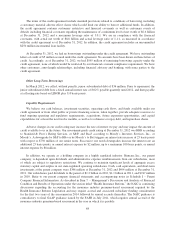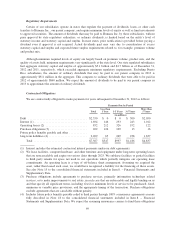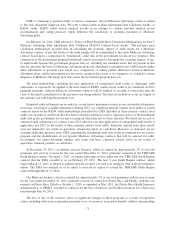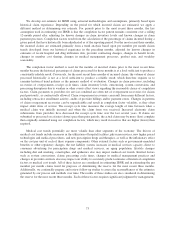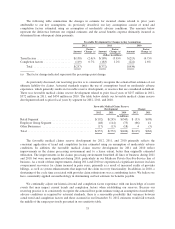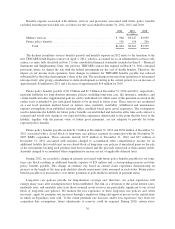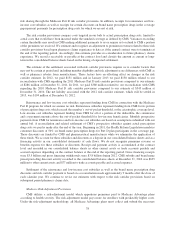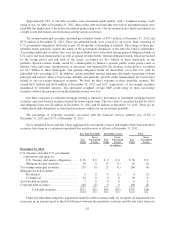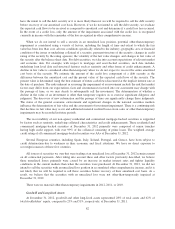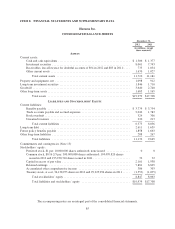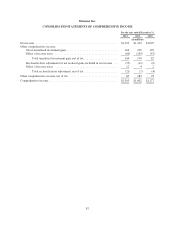Humana 2012 Annual Report Download - page 88
Download and view the complete annual report
Please find page 88 of the 2012 Humana annual report below. You can navigate through the pages in the report by either clicking on the pages listed below, or by using the keyword search tool below to find specific information within the annual report.risk sharing through the Medicare Part D risk corridor provisions. In addition, receipts for reinsurance and low-
income cost subsidies as well as receipts for certain discounts on brand name prescription drugs in the coverage
gap represent payments for prescription drug costs for which we are not at risk.
The risk corridor provisions compare costs targeted in our bids to actual prescription drug costs, limited to
actual costs that would have been incurred under the standard coverage as defined by CMS. Variances exceeding
certain thresholds may result in CMS making additional payments to us or require us to refund to CMS a portion
of the premiums we received. We estimate and recognize an adjustment to premiums revenue related to these risk
corridor provisions based upon pharmacy claims experience to date as if the annual contract were to terminate at
the end of the reporting period. Accordingly, this estimate provides no consideration to future pharmacy claims
experience. We record a receivable or payable at the contract level and classify the amount as current or long-
term in the consolidated balance sheets based on the timing of expected settlement.
The estimate of the settlement associated with risk corridor provisions requires us to consider factors that
may not be certain at period end, including member eligibility and risk adjustment score differences with CMS as
well as pharmacy rebates from manufacturers. These factors have an offsetting effect on changes in the risk
corridor estimate. In 2012, we paid $131 million and in January 2013 we paid $158 million related to our
reconciliation with CMS regarding the 2011 Medicare Part D risk corridor provisions compared to our estimate
of $286 million at December 31, 2011. In 2011, we paid $380 million related to our reconciliation with CMS
regarding the 2010 Medicare Part D risk corridor provisions compared to our estimate of $345 million at
December 31, 2010. The net liability associated with the 2012 risk corridor estimate, which will be settled in
2013, was $194 million at December 31, 2012.
Reinsurance and low-income cost subsidies represent funding from CMS in connection with the Medicare
Part D program for which we assume no risk. Reinsurance subsidies represent funding from CMS for its portion
of prescription drug costs which exceed the member’s out-of-pocket threshold, or the catastrophic coverage level.
Low-income cost subsidies represent funding from CMS for all or a portion of the deductible, the coinsurance
and co-payment amounts above the out-of-pocket threshold for low-income beneficiaries. Monthly prospective
payments from CMS for reinsurance and low-income cost subsidies are based on assumptions submitted with our
annual bid. A reconciliation and related settlement of CMS’s prospective subsidies against actual prescription
drug costs we paid is made after the end of the year. Beginning in 2011, the Health Reform Legislation mandates
consumer discounts of 50% on brand name prescription drugs for Part D plan participants in the coverage gap.
These discounts are funded by CMS and pharmaceutical manufacturers while we administer the application of
these funds. We account for these subsidies and discounts as a deposit in our consolidated balance sheets and as a
financing activity in our consolidated statements of cash flows. We do not recognize premiums revenue or
benefits expense for these subsidies or discounts. Receipt and payment activity is accumulated at the contract
level and recorded in our consolidated balance sheets in other current assets or trade accounts payable and
accrued expenses depending on the contract balance at the end of the reporting period. Gross financing receipts
were $3.5 billion and gross financing withdrawals were $3.8 billion during 2012. CMS subsidy and brand name
prescription drug discount activity recorded to the consolidated balance sheets at December 31, 2012 was $635
million to other current assets and $77 million to trade accounts payable and accrued expenses.
Settlement of the reinsurance and low-income cost subsidies as well as the brand name prescription drug
discounts and risk corridor payment is based on a reconciliation made approximately 9 months after the close of
each calendar year. We continue to revise our estimates with respect to the risk corridor provisions based on
subsequent period pharmacy claims data.
Medicare Risk-Adjustment Provisions
CMS utilizes a risk-adjustment model which apportions premiums paid to Medicare Advantage plans
according to health severity. The risk-adjustment model pays more for enrollees with predictably higher costs.
Under the risk-adjustment methodology, all Medicare Advantage plans must collect and submit the necessary
78


